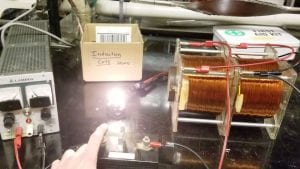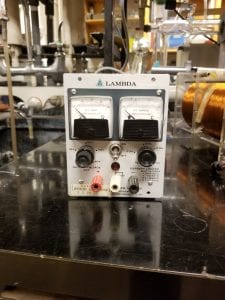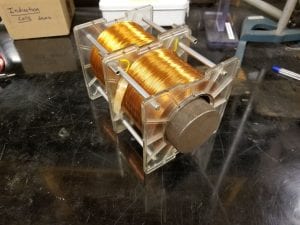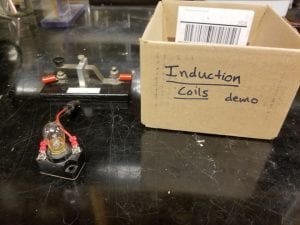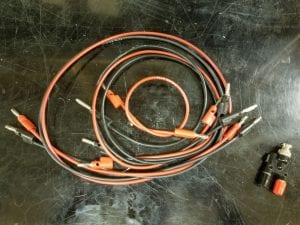This demo shows that current flowing through a large inductor will build a magnetic field at its center. In addition, this magnetic field contains an energy which can be converted into electromagnetic radiation through the light bulb shown above in Figure 1. It is also possible to demonstrate mutual inductance between two inductors using the materials from this demo.
- DC power supply: The Lambda power supply is used to supply 40 V and up to 1.5 Amps to the system.
- Induction Coils and Core: For our inductor we use two large coils of 3400 turns each connected in series. In addition, an iron core is inserted to strengthen the central magnetic field created.
- Induction Coil Box: Contains a small light bulb rated for 120 V and 15 Watts and a momentary switch.
- Connectors: This demo needs 6 banana jacks and one BNC to banana jack connector as shown below.
- Video Camera: The camera helps students see small sparks between the momentary switch which might otherwise go unnoticed.
Setup:
To begin setup for this lab, assemble the circuit as shown below.
Connect the two induction coils in series with one banana cable. Then connect this combination in series with the Lambda power supply and momentary switch. This creates an open circuit when the momentary switch isn’t pressed down. Finally, connect the light bulb in parallel with the induction coils. This ensures that energy accumulated in the magnetic field within the iron core will be transferred to the light bulb until it is dissipated as heat and light. With the proper circuit assembled we can move to the demonstration itself.
Demonstration:
Without placing the iron core inside the coil, press the switch. The light bulb will shine dimly and turn off with no visible effect once the switch is released. Without the iron core the magnetic field is relatively weak and won’t generate a spike in light emitted when releasing the switch.
Now place the core inside the coil and press the switch again. Releasing the switch will produce a burst of light from the bulb and a spark between the contacts of the switch. It is best to perform this demo with the lights dimmed to observe this spark.
Explanation:
The two coils we’ve connected in series create one large inductor. Once current is steadily flowing through the inductor windings a magnetic field is created in the center. We will make use of the magnetic field within a solenoid with N turns per length and current I flowing to demonstrate this.
from Ampere’s law
From this equation, we can see why current flowing through our inductor will create a magnetic field within its center.
Without an iron core this magnetic field is relative small due to the lack of material to magnetize. With the iron core inserted the magnetic field becomes much stronger. This is due to the large magnetization introduced by the iron atoms. Each iron atom is a strong magnetic dipole which is aligned by the external magnetic field, causing a net magnetization within the material. The effect is a much stronger magnetic field at the center of the inductor, which stores a much larger amount of energy.
Once the current stabilizes, visible on the Lambda source, we know that the magnetic field has reached its peak. Upon releasing the switch, we’ve disconnected the inductor from the power supply. The only remaining circuit is the inductor in series with the light bulb. At this point we need several electromagnetism equations to explain the following behavior.
where
for an inductor
In these equations we use to represent the electromotive force caused by a change of the magnetic flux
in time.
When we begin to release the switch this will change our steady state current and magnetic field. Upon releasing it, we are effectively open circuiting, disconnecting, the power supply. This will stop current from flowing into the inductor as it had been while the switch was pressed in. However, this drastic decrease in current causes a large spike in . This spike causes the inductor to create an electromotive force
to counteract the decrease in current. This translates to a voltage applied across the inductor creating current flow to oppose the decrease in current from the power source.
Now that we’ve disconnected the power supply, the inductor and light bulb form their own isolated series circuit. Once the coils generate this electromotive force, the light bulb will also be affected by this voltage. With those steps, we’ve shown why the light bulb produces a bright flash when releasing the momentary switch. The spike in creates a momentarily large voltage which is dissipated quickly through the light bulb.
One phenomenon still unaddressed is the source of power for this light bulb to shine. Because the inductor and light bulb are isolated, power must be supplied by the decrease of the magnetic field within the iron core. This power is delivered through the voltage generated by the inductor and the current this produces.
The power delivered to the light bulb surges as the supply is disconnected because the current is essentially a step function. The second it is removed, becomes theoretically infinite which causes the flash of the light bulb.
The high voltage, or from above, will causes a spark at the switch after it is released. The potential difference between the two conductive plates becomes large enough to ionize the air molecules. This process is called dielectric breakdown, which renders the air between the two plates momentarily conductive. This allows for electrical conduction between the plates through the air. As current passes between the two conductive plates, some energy is removed from the inductor’s magnetic field and safely discharged to ground. This process can be shown to students using the provided video camera and zooming in on the switch contacts with the lights dimmed. The same dielectric breakdown occurs during a lighting strike, which is a good place to begin describing the effect to students.
One final effect we need to explain is the difference between reactions of the light bulb when the iron core is inserted and when it is removed. The important equation to note is
for an inductor.
In this equation, the key relation is that is directly proportional to inductance L. We are interested in this relation because L can also be viewed as the inductor’s ability to store energy in a magnetic field. With increasing L, we know the inductor will create a stronger B field for the same input current. From this, we expect that inserting the iron core will greatly increase the inductance of the system.The inductor can now magnetize the iron atoms to create a stronger B field and store more energy. With this increased amount of stored energy, the inductor will cause a much brighter flash in the light bulb and a spark at the switch.
Written by Noah Peake
